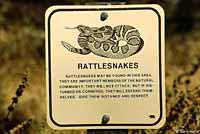
A Guide to California's
Reptiles and Amphibians
Rattlesnake Sounds and Video
| Sound Recordings of Rattlesnakes | |||
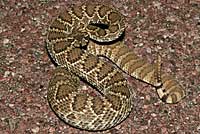 |
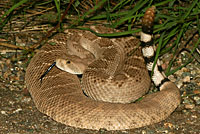 |
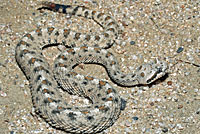 |
 |
| This is an 18 second recording of the rattling of a Northern Mohave Rattlesnake, Crotalus scutulatus scutulatus, shown above. | This is a 10 second recording of rattling and hissing of the Western Diamond-backed Rattlesnake, Crotalus atrox, shown above. | This is a 9 second recording of the faint rattling of a Mohave Sidewinder, Crotalus cerastes cerastes, shown above. | This is an 8 second recording of the rattling of a Northern Pacific Rattlesnake, Crotalus oreganus oreganus, shown above. |
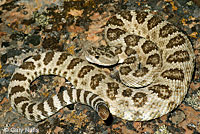 |
 |
 |
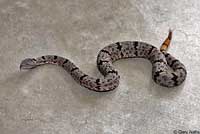 |
| This is a recording of the rattle of a captive Great Basin Rattlesnake (not the snake shown above) recorded with the snake in a plastic bucket in cool temperatures. © Jeff Rice (Listen to more recordings of this snake at the Western Soundscape Archive) Not to be used without permission. |
Indoor recording of the rattling of a captive adult Southern Pacific Rattlesnake (courtesy of the Arizona-Sonora Desert Museum.) © Jeff Rice / Western Soundscape Archive Not to be used without permission. | Indoor recording of the rattling of a captive adult Sonoran Sidewinder (courtesy of the Arizona-Sonora Desert Museum.) © Jeff Rice / Western Soundscape Archive Not to be used without permission. | Indoor recording of the rattling of a captive adult Banded Rock Rattlesnake (courtesy of the Arizona-Sonora Desert Museum.) © Jeff Rice / Western Soundscape Archive Not to be used without permission. |
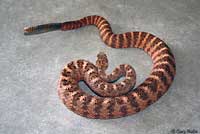 |
 |
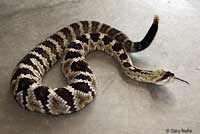 |
|
| Indoor recording of the rattling of a captive adult Tiger Rattlesnake (courtesy of the Arizona-Sonora Desert Museum.) © Jeff Rice / Western Soundscape Archive Not to be used without permission. |
Indoor recording of the rattling of a captive adult Arizona Ridge-nosed Rattlesnake (courtesy of the Arizona-Sonora Desert Museum.) This species has small rattles which make a relatively quiet buzzing sound. © Jeff Rice / Western Soundscape Archive Not to be used without permission. |
Indoor recording of the rattling of a captive adult Black-tailed Rattlesnake (courtesy of the Arizona-Sonora Desert Museum.) © Jeff Rice / Western Soundscape Archive Not to be used without permission. | |
| Short Videos of Rattlesnakes | |||
| (You need the QuickTime player to play most of these. If your web browser does not support QuickTime, use a different browser that does.) |
|||
| Crotalus atrox - Western Diamond-backed Rattlesnake | |||
 |
 |
||
| Several views of a Western Diamond-backed Rattlesnake rattling and taking a defensive pose with head and tail elevated, then crawling away. It keeps rattling as it crawls away into a bush. |
A Western Diamond-backed Rattlesnake rattles in a defensive pose in Sierra County, New Mexico. | ||
| Crotalus cerastes - Sidewinder | |||
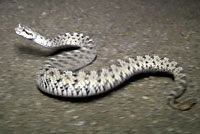 |
 |
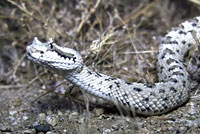 |
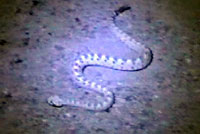 |
| A Mohave Desert Sidewinder in motion on a windy night. |
A Colorado Desert Sidewinder found on a road at night rattles and sidewinds. | A Mohave Desert Sidewinder sidewinds and crawls across the desert. | Watch a Mohave Desert Sidewinder crawl at night slowly then very quickly over the sand with its unique sideways locomotion. |
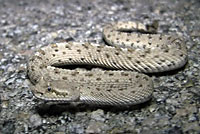 |
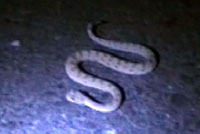 |
||
| A Colorado Desert Sidewinder sidewinding at night. | A Colorado Desert Sidewinder crawls with its unique sideways locomotion. |
||
| Crotalus cerberus - Arizona Black Rattlesnake | |||
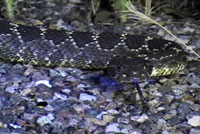 |
|||
| An Arizona Black Rattlesnake, found at the edge of a road at night in Graham County, Arizona, crawls back into the grass. It did not rattle at all, so there is no sound here. |
|||
| Crotalus pyrrhus - Southwestern Speckled Rattlesnake | |||
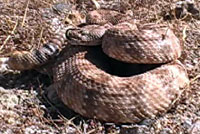 |
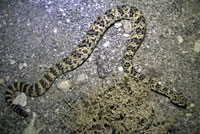 |
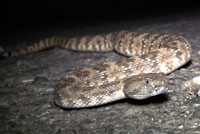 |
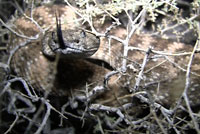 |
| A coiled Southwestern Speckled Rattlesnake rattles, uncoils, and crawls into a bush. (The sound has been deleted in the middle due to excessive background noise.) |
A large adult Southwestern Speckled Rattlesnake rattling and crawling away on a windy night. | A Southwestern Speckled Rattlesnake crawls across a road and up into a bush in Imperial County. | A Southwestern Speckled Rattlesnake rattles from up in a bush in Imperial County. |
| Crotalus molossus - Black-tailed Rattlesnake | |||
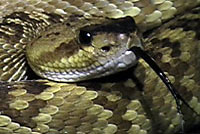 |
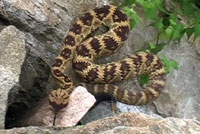 |
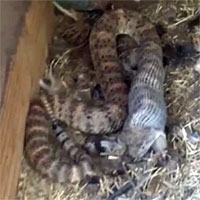 |
|
| Views of a Black-tailed Rattlesnake in the Pajarito Mountains of Santa Cruz County, Arizona. |
A basking Black-tailed Rattlesnake high up in the Pinaleno mountains of Graham County, Arizona. | This short video shows an adult Southwestern Speckled Rattlesnake in the last stages of swallowing a chicken in a chicken coop in the Santa Ana Mountains of Orange County. © Kevin Law |
|
| Crotalus oreganus - Western Rattlesnake | |||
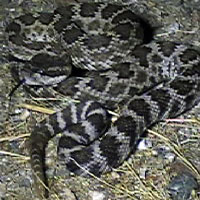 |
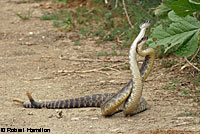 |
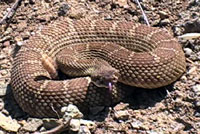 |
 |
| A Southern Pacific Rattlesnake poses and rattles and crawls away at night in Los Angeles County. | Robert Hamilton's YouTube Video of two male Southern Pacific Rattlesnakes wrestling for dominance. | A Northern Pacific Rattlesnake in Contra Costa County coils defensively, rattles, and senses the air with its tongue. | A Northern Pacific Rattlesnake rattles its tail. |
 |
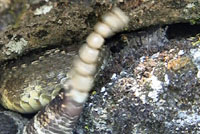 |
 |
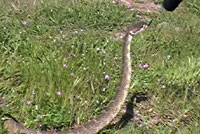 |
| This video begins with a squirrel's high-pitched alarm call coming from a large group of shrubs in the Sierra Nevada mountains. When I got closer the squirrel ran away and I saw this Northern Pacific Rattlesnake climbing down a branch then farther back into the bushes. Later, after the camera batteries died, the snake returned and crawled outside the shrubs while the squirrel called and ran around outside the bushes near the snake, but outside of its striking range. |
A Northern Pacific Rattlesnake in the Sierra Nevada mountains crawls into a crack and shakes its tail. | Most rattlesnakes will do exactly what this Northern Pacific Rattlesnake did when I encountered it in the late afternoon on a mountain road - they turn and crawl quickly away, with a little rattling thrown in as a warning. Rattlesnakes are often depicted in fiction as aggressors, leaping and striking viciously, often for no reason other than to give the hero an excuse to kill it to prove himself. The truth is that rattlesnakes are almost always defensive, not offensive, when they encounter humans, wanting nothing more than to escape, and the least heroic thing someone can do is to automatically kill them. | A Northern Pacific Rattlesnake is seen slowly following a snake hook with curiosity, not aggression. The hook had been used earlier to pick up a breeding pair of snakes, and we decided that this one was probably a male that smelled the scent of the breeding female on the hook. |
 |
 |
 |
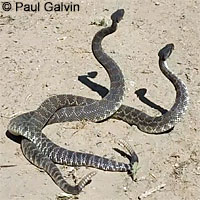 |
| A juvenile Northern Pacific Rattlesnake rattles and crawls off a road in the foothills of Fresno County in early Fall. |
A Great Basin Rattlesnake crawls under a bush and rattles in Siskiyou County. | A Great Basin Rattlesnake rattles at night in the Nevada desert. |
A short video of two male Southern Pacific Rattlesnakes wrestling for dominance over a female snake that is probably hiding nearby during the May breeding season, in Orange County. © Paul Galvin |
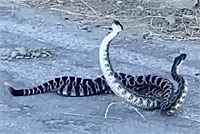 |
|||
| A pair of male Southern Pacific Rattlesnakes wrestle over a mate in Los Angeles County. | |||
| Crotalus pricei - Western Twin-spotted Rattlesnake | |||
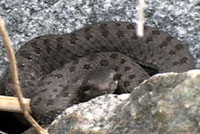 |
|||
| A Western Twin-spotted Rattlesnake basks on talus high in the Pinaleno mountains of Graham County, Arizona. |
|||
| Crotalus ruber - Red Diamond Rattlesnake | |||
 |
 |
 |
|
| A large old Red Diamond Rattlesnake rattles on top of a boulder in coastal San Diego County. | A close view of a rattling Red Diamond Rattlesnake tail. | A Red Diamond Rattlesnake crawls across hot sand at mid day in San Diego County, then takes shelter between some rocks. | |
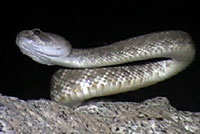 |
 |
||
| A large adult Red Diamond Rattlesnake crawls up some large boulders at the edge of a desert wash in San Diego County. After trying to climb up past the top of the boulder, it crawled back down. Despite the bright lights, it did not appear to notice me and continued its nocturnal wandering. |
A Red Diamond Rattlesnake found on a desert road at night. | ||
| Crotalus scutulatus scutulatus - Northern Mohave Rattlesnake | |||
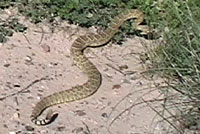 |
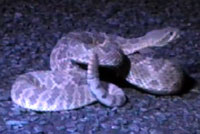 |
||
| A Northern Mohave Rattlesnake crawls off a road in Arizona. | Several views of a Northern Mohave Rattlesnake rattling and taking a defensive posture. |
||
| Crotalus stephensi - Panamint Rattlesnake | |||
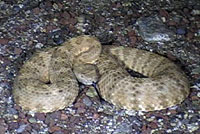 |
|||
| A Panamint Rattlesnake found on a road at night in Inyo County, rattles and crawls away. |
|||
| Rattlesnake Mimics or Natural Sounds that are Similar to the Sound of a Rattlesnake Rattling its Tail | |||
 |
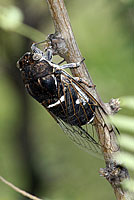 |
||
| Burrowing Owls, Athene cunicularia, are known to imitate the sound of a rattlesnake when they are threatened, typically when a predator such as a ground squirrel attempts to enter their burrow. The sound is thought to scare off the predator. (See Batesian mimicry.) This is a recording of three fledgling Burrowing Owls mimicking the sound of a rattlesnake, recorded at the Snake River Birds of Prey National Conservation Area in southern Idaho.The birds were temporarily placed in a plastic bucket during a conservation study by Dr. James Belthoff of Boise State University. © Jeff Rice (Listen to more recordings of these owls at the Western Soundscape Archive) Not to be used without permission. |
Cicadas, during part of their performance, sound very much like the rattling of a rattlesnake. This is not really a mimic, but a sound that can be confused for a rattlesnake. It might even startle you if the insect suddenly starts rattling while you're walking through the desert. The cicada heard here was recorded during daylight in Pima County, Arizona. Cicadas in California's deserts make a similar sound. (The picture above shows a cicada photographed in Texas.) Notice the rattling sounds, followed by a loud electronic sound which is then followed by the rattling sound. Sometimes this is repeated many times. | ||
 |
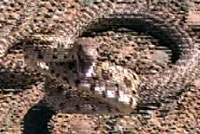 |
 |
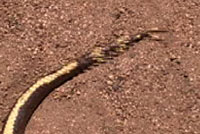 |
| In this short video, a distressed Pacific Gophersnake shakes its tail rapidly, which makes a buzzing sound as the tail touches the ground. This behavior might be a mimic of a rattlesnake's rattling, or it could be a similar behavior that helps to warn off an animal that could be a threat to the gopher snake. | The same Pacific Gophersnake as the one to the left shows its defensive arsenal, which includes coiling, puffing up, and elevating the body, flattening the head into a triangular shape, hissing loudly, shaking the tail, and striking repeatedly. This behavior often causes a gopher snake to be mistaken for a rattlesnake, which defends itself in a similar way. The gophersnake's hissing can be mistaken for the sound of a rattle. |
A huge Sonoran Gophersnake puts on an impressive defensive display of hissing and blowing. Gopher snakes have a specially-developed epiglottis which increases the sound of their hiss when air is forced through the glottis. Rattlesnakes also hiss, which is often overshadowed by the louder rattling. |
A distressed San Diego County California Kingsnake vibrates its tail. |
 |
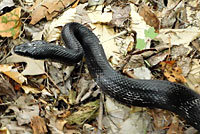 |
 |
|
| This is a short video showing a large Bullsnake in Kansas rear back in a defensive striking posture, then strike with a loud hiss, and continue to make a rattling hissing sound. Bull snakes are a subspecies of gophersnake not found in California. They also have a specially-developed epiglottis which increases the sound of their hiss when air is forced through the glottis. |
I spotted a Gray Ratsnake basking in the woods in Tennessee so I turned the video camera on and walked towards it. It moved away slowly and after a few minutes it began to buzz the tip of its tail in the dry leaves to scare me away. This behavior could be an imitation of the rattling of a rattlesnake, or it could just be a defensive behavior similar to that which caused the evolution of the rattlesnake's rattle. | This is a shorter version of the ratsnake video shown to the left that shows only the tail buzzing behavior of the Gray Ratsnake. | |
Return to the Top
© 2000 -
